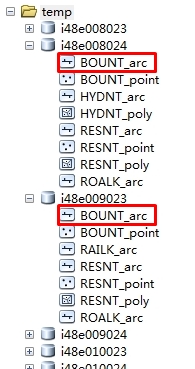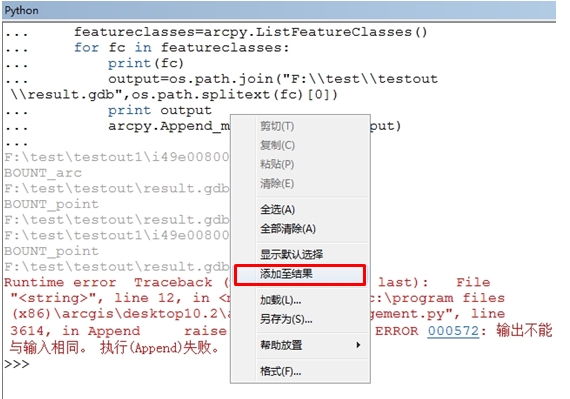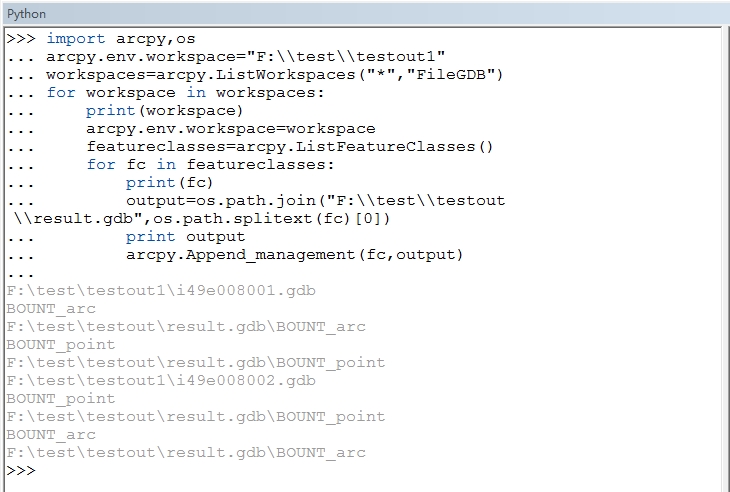不同gdb,相同数据集合并
众所周知,数据处理是GIS中一项重要且繁琐的工作,处理数据的工具和方法也太多了,在做数据处理的时候,经常会遇到这样的问题:对存储在不同gdb中、并且数据集名称相同的数据进行合并处理:
如图:数据组织如下,每个gdb中都存储了一些列FeatureClass,(但gdb中的FeatureClass数量并不相同)

思路是:
1.先对每个gdb中的数据进行处理,使得每个gdb中的featureclass数量和名称相同。由于对Engine比较熟悉,这里我是用Engine进行处理的,具体代码如下:
private function Execute(){ //初始执行函数:
string templatePath = @"F:\testout";
DirectoryInfo directoryInfo = new DirectoryInfo(templatePath);
DirectoryInfo[] dirInfo = directoryInfo.GetDirectories();
string yy = dirInfo[].Name;
string FeatureClassName = "ROALK_arc"; //FeatureClass名称,这里可以设置一个数组,存储所有的FeatureClass
for (int i = ; i < dirInfo.Length; i++)
{
string gdbName = dirInfo[i].Name;
//打开filegdb
bool value = oper(@"F:\testout\" + gdbName, FeatureClassName);//判断FeatureClass是否存在
string path = @"F:\testout\" + gdbName;
if (value == false)
{
copyFeatureClass(path, FeatureClassName);
}
}
}
public bool oper(string filename,string featureClassName) //判断FeatureClass是否存在
{
IWorkspace2 workspace = null;
IWorkspaceFactory2 workspaceFactory = new FileGDBWorkspaceFactoryClass();
workspace = workspaceFactory.OpenFromFile(filename, ) as IWorkspace2;
IFeatureWorkspace featureWorkspace = workspace as IFeatureWorkspace;
bool flag = workspace.get_NameExists(ESRI.ArcGIS.Geodatabase.esriDatasetType.esriDTFeatureClass, featureClassName);
return flag;
}
public bool oper(string filename,string featureClassName) //判断是gdb中是否存在某个FeatureClass
{
IWorkspace2 workspace = null;
IWorkspaceFactory2 workspaceFactory = new FileGDBWorkspaceFactoryClass();
workspace = workspaceFactory.OpenFromFile(filename, ) as IWorkspace2;
IFeatureWorkspace featureWorkspace = workspace as IFeatureWorkspace;
bool flag = workspace.get_NameExists(ESRI.ArcGIS.Geodatabase.esriDatasetType.esriDTFeatureClass, featureClassName);
return flag;
}
//拷贝所有的FeatureClass到gdb,并删除里面的数据,保证每个featureclass为空,注:D:\Data\Shapefiles存储了所有的要合并的FeatureClass的空图层,便于拷贝。
private void convert()
{
IWorkspaceName sourceWorkspaceName = new WorkspaceNameClass
{
WorkspaceFactoryProgID = "esriDataSourcesFile.ShapefileWorkspaceFactory",
PathName = @"D:\Data\Shapefiles"
};
IName sourceWorkspaceIName = (IName)sourceWorkspaceName;
IWorkspace sourceWorkspace = (IWorkspace)sourceWorkspaceIName.Open(); // Create a name object for the target (file GDB) workspace and open it.
IWorkspaceName targetWorkspaceName = new WorkspaceNameClass
{
WorkspaceFactoryProgID = "esriDataSourcesGDB.FileGDBWorkspaceFactory",
PathName = @"D:\Data\Public.gdb"
};
IName targetWorkspaceIName = (IName)targetWorkspaceName;
IWorkspace targetWorkspace = (IWorkspace)targetWorkspaceIName.Open(); // Create a name object for the source dataset.
IFeatureClassName sourceFeatureClassName = new FeatureClassNameClass();
IDatasetName sourceDatasetName = (IDatasetName)sourceFeatureClassName;
sourceDatasetName.Name = "BOUNT_arc";
sourceDatasetName.WorkspaceName = sourceWorkspaceName; // Create a name object for the target dataset.
IFeatureClassName targetFeatureClassName = new FeatureClassNameClass();
IDatasetName targetDatasetName = (IDatasetName)targetFeatureClassName;
targetDatasetName.Name = "BOUNT_arc";
targetDatasetName.WorkspaceName = targetWorkspaceName; // Open source feature class to get field definitions.
IName sourceName = (IName)sourceFeatureClassName;
IFeatureClass sourceFeatureClass = (IFeatureClass)sourceName.Open(); // Create the objects and references necessary for field validation.
IFieldChecker fieldChecker = new FieldCheckerClass();
IFields sourceFields = sourceFeatureClass.Fields;
IFields targetFields = null;
IEnumFieldError enumFieldError = null; // Set the required properties for the IFieldChecker interface.
fieldChecker.InputWorkspace = sourceWorkspace;
fieldChecker.ValidateWorkspace = targetWorkspace; // Validate the fields and check for errors.
fieldChecker.Validate(sourceFields, out enumFieldError, out targetFields);
if (enumFieldError != null)
{
// Handle the errors in a way appropriate to your application.
MessageBox.Show("Errors were encountered during field validation.");
} // Find the shape field. String shapeFieldName = sourceFeatureClass.ShapeFieldName;
int shapeFieldIndex = sourceFeatureClass.FindField(shapeFieldName);
IField shapeField = sourceFields.get_Field(shapeFieldIndex); // Get the geometry definition from the shape field and clone it.
IGeometryDef geometryDef = shapeField.GeometryDef;
IClone geometryDefClone = (IClone)geometryDef;
IClone targetGeometryDefClone = geometryDefClone.Clone();
IGeometryDef targetGeometryDef = (IGeometryDef)targetGeometryDefClone; // Cast the IGeometryDef to the IGeometryDefEdit interface.
IGeometryDefEdit targetGeometryDefEdit = (IGeometryDefEdit)targetGeometryDef;
// Set the IGeometryDefEdit properties.
targetGeometryDefEdit.GridCount_2 = ;
targetGeometryDefEdit.set_GridSize(, 0.75); IFeatureDataConverter featureDataConverter = new FeatureDataConverterClass();
IEnumInvalidObject enumInvalidObject = featureDataConverter.ConvertFeatureClass
(sourceFeatureClassName, null, null, targetFeatureClassName,
targetGeometryDef, targetFields, "", , ); // Check for errors.
IInvalidObjectInfo invalidObjectInfo = null; enumInvalidObject.Reset(); }
2.合并,在ArcGIS中采用Python:
可以参考http://blog.csdn.net/esrichinacd/article/details/14146653
最后需要注意的地方是:在10.2的ArcMap中执行时会如下错误

我也是检查了好长时间,原因是10.2的ArcMap中执行结果会自动添加到ArcMap中,即使右键取消“添加至结果”也不行。(导致了第二次循环的时候合并的数据是结果集相同的数据的合并,所以会报上面错误)

所以这里,我们执行的时候可以到ArcCatalog中执行python脚本:

不同gdb,相同数据集合并的更多相关文章
- R语言数据集合并、数据增减、不等长合并
每每以为攀得众山小,可.每每又切实来到起点,大牛们,缓缓脚步来俺笔记葩分享一下吧,please~ --------------------------- 数据选取与简单操作: which 返回一个向量 ...
- hadoop小文件合并
1.背景 在实际项目中,输入数据往往是由许多小文件组成,这里的小文件是指小于HDFS系统Block大小的文件(默认128M), 然而每一个存储在HDFS中的文件.目录和块都映射为一个对象,存储在Nam ...
- R︱高效数据操作——data.table包(实战心得、dplyr对比、key灵活用法、数据合并)
每每以为攀得众山小,可.每每又切实来到起点,大牛们,缓缓脚步来俺笔记葩分享一下吧,please~ --------------------------- 由于业务中接触的数据量很大,于是不得不转战开始 ...
- SAS︱数据索引、数据集常用操作(set、where、merge、append)
代码部分大多来源于姚志勇老师的<SAS编程与数据挖掘商业案例>. 每每以为攀得众山小,可.每每又切实来到起点,大牛们,缓缓脚步来俺笔记葩分享一下吧,please~ ------------ ...
- Hadoop实战项目:小文件合并
项目背景 在实际项目中,输入数据往往是由许多小文件组成,这里的小文件是指小于HDFS系统Block大小的文件(默认128M),早期的版本所定义的小文件是64M,这里的hadoop-2.2.0所定义的小 ...
- spark系列-2、Spark 核心数据结构:弹性分布式数据集 RDD
一.RDD(弹性分布式数据集) RDD 是 Spark 最核心的数据结构,RDD(Resilient Distributed Dataset)全称为弹性分布式数据集,是 Spark 对数据的核心抽象, ...
- Atitit 数据存储视图的最佳实际best practice attilax总结
Atitit 数据存储视图的最佳实际best practice attilax总结 1.1. 视图优点:可读性的提升1 1.2. 结论 本着可读性优先于性能的原则,面向人类编程优先于面向机器编程,应 ...
- Webform Application传值 ViewState
Application:所有的会话共享一个Application空间,任何一个人改变Application的内容,其他人都会发现被改变了.Application中的内容不会被自动释放 存放位置:服务端 ...
- ASP.Net WebForm温故知新学习笔记:二、ViewState与UpdatePanel探秘
开篇:经历了上一篇<aspx与服务器控件探秘>后,我们了解了aspx和服务器控件背后的故事.这篇我们开始走进WebForm状态保持的一大法宝—ViewState,对其刨根究底一下.然后,再 ...
随机推荐
- GO語言視頻教程下載
需要的朋友可以加QQ群195112,在群共享內可以下載到.
- c++ const放置的位置
标准中int const a 与 const int a 是完全等价的.正因为如此,会有很多各种不同的风格,同样的还有"*是跟类型还是变量?",比如char* p与 char *p ...
- Log4j2常见使用示例及Syslog/Syslog-ng
准备工作 打开http://logging.apache.org/log4j/,点击左侧Download,我下载的是Apache Log4j 2 binary (zip),目前是2.0.2版本.解压后 ...
- VMware Workstation安装RedHat Linux 9
RedHatLinux是目前世界上使用最多的Linux操作系统.因为它具备最好的图形界面无论是安装.配置还是使用都十分方便.下面我将介绍使用VMware Workstation安装RedHat Lin ...
- blueImp/jQuery file upload 的正确用法(限制上传大小和文件类型)
这个插件太出名了,几乎能完成所有能想象的到的效果,包括进度条.拖拽.甚至现在已经完美支持图片视频等的处理,三个字形容就是屌爆了.最近在做上传这一部分,发现网上对于上传文件大小的限制和类型检测等的方法都 ...
- [Aaronyang] 写给自己的WPF4.5 笔记20 [3d课 1/4]
假设你是高中毕业的,ok,数学知识几何知识中,我们学过 x,y,z 3个轴然后就可以画出形状了. 1. 新建空白窗体,grid换成canvas,然后新增一个Viewport3D元素 3d中显示的 ...
- python数据结构之图的实现
python数据结构之图的实现,官方有一篇文章介绍,http://www.python.org/doc/essays/graphs.html 下面简要的介绍下: 比如有这么一张图: A -> B ...
- Living one day at a time (update for a long time)
1, http://acm.hdu.edu.cn/showproblem.php?pid=1228 2014-04-14 10:39:52 分析:字符串处理题... #include<iost ...
- Asp.net Core WebApi 使用Swagger做帮助文档,并且自定义Swagger的UI
WebApi写好之后,在线帮助文档以及能够在线调试的工具是专业化的表现,而Swagger毫无疑问是做Docs的最佳工具,自动生成每个Controller的接口说明,自动将参数解析成json,并且能够在 ...
- 2. MongoDB基本操作 —— 用Mongo.exe操作数据库增删改查
一.开篇 传统的关系数据库一般由数据库(database).表(table).记录(record)三个层次概念组成,MongoDB是由数据库(database).集合(collection).文档对象 ...
